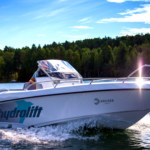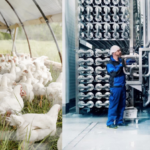Vi har mye av teknologien og kunnskapen som trengs for å bygge et nytt og bærekraftig energiøkosystem. Det handler ikke om magi – men kun visjon og vilje, skriver DNVs Bjørn K. Haugland.
Last week was the 40th anniversary of ONS – a world-leading forum for the oil and gas industry. Since its establishment in 1974, the conference has been a front-row observer of the Norwegian petroleum story.
The search for oil on the Norwegian continental shelf started on July 19, 1966, when the first hole was drilled from “Ocean Traveller”, a rig transferred from the Gulf of Mexico and, it turned out, not well-suited to the harsher environment of the North Sea. Three years passed before any oil was found. Then, on August 21, 1969, the specially built rig “Ocean Viking” struck oil and Norway had its first oil field.
Ocean Traveller’s struggles gave just a small hint of the technological challenges presented by the North Sea. But guided by a farsighted Norwegian government, oil companies, suppliers and universities invested in the capabilities required to meet these challenges. We all know the result: these pioneers were able to build up a formidable oil and gas sector that helped create one of the world’s most developed countries.
The question now is, what next?
This was the question that inspired the theme of this year’s ONS: “Change”. I had the great pleasure moderating a panel discussing the drivers of the ongoing energy transformation.
These are my main takeaways:
- The fossil fuel industry is facing increasing cost challenges. During the last years oil exploration investments have risen steeply while profitability has dropped. Almost all new fields require an oil price of 80 dollars per barrel to break even. This squeeze applies not just to oil and gas but also to the coal sector, where new projects are increasingly being put on hold because it is simply too expensive to pull the coal out of the ground. The spread of a carbon tax or a similar instrument would only increase the cost burden.
- The fossil fuel industry’s image is also being challenged. Science tells us clearly that continued growth in fossil energy will lead to climate crises with high cost for humans and societies. Societies will not tolerate business as usual. At the same time, concerns and transparency to such as for example the sector’s water usage and the true magnitude of methane leakages – are challenging the industry’s relationship with society.
- Meanwhile the cost of solar and wind energy is steadily being compressed. The renewable industry has taken a strong position over the last years, and as the scaling proceeds it is reasonable to expect the compression to continue.
- There are signs that policymakers of major countries are beginning to wake up. Both China and the US are ramping up climate action, setting higher national targets and started to collaborate prior to Paris 2015. Spurred by the pollution in its big cities, China is thinking big, implementing fast and inspiring change elsewhere.
- Sustainable technologies are developing at breakneck speed, chipping away at the position of today’s dominant market players. In just a few years Tesla harnessed a completely new technology to take a global lead in sustainable automotive. Tesla’s new battery factory and expansion of charging infrastructure will strengthen this position. Free charging is a compelling offer for consumers in a world of continuously higher gas prices.
- Tried-and-tested business models are coming under fire. The current state of the European power sector shows how easy it is to disturb business as usual, creating space for new business models to take root and flourish.
- The financial sector is increasingly questioning the long-term robustness of fossil investments. The stranded asset debate is affecting some investor’s views about fossil fuel investments. As the Norwegian clean tech investor Jens Ulltveit Moe expressed in his closing comment at ONS, “to invest in fossil fuel today is like investing in tobacco 40 years ago”.
The oil and gas industry has certainly experienced and managed change in the past; however even stronger signs of change seem to be on the horizon.
How can oil and gas producing countries and companies prepare for the future?
Norway’s situation could provide us with some clues.
Back in the sixties the weakness of Norway economy was such that foreign companies needed to play a big role in getting the oil industry off the ground. Yet Norway’s deep experience in another sector – shipping – empowered us to build a new industry that would bring the economy into another league.
Today, Norway is in a much stronger position. Not only is the economy strong – we have far greater breadth and depth of technology, competence and people. Our oil and gas industry – just like the shipping industry before it – provides an excellent platform for a new industrial era for Norway.
Take offshore floating wind as an example. Here Norway can apply its offshore expertise to create a home market while expanding globally. By combining floating wind with new energy storage technologies, smart grids and interconnectors to Europe we can build an energy system suited to the future.
Elon Musk has said, “If you go back back a few hundred years, what we take for granted today would seem like magic – being able to talk to people over long distances, to transmit images, flying, accessing vast amounts of data like an oracle. These are all things that would have been considered magic a few hundred years ago.”
We know we are capable of dramatic change, and we know that we already have much of the technology, solutions and know-how we need to transform to a new – and sustainable – energy system.
It’s not magic – we just need a vision and the will – and get going.
Om Bjørn K. Haugland
Bjørn Kj. Haugland is Executive Vice President and the Chief Sustainability Officer (CSO) in DNV GL Group. He is responsible for DNV-GL Group’s sustainability agenda and he is the Chairman of DNV GL Corporate Sustainability Board. Haugland has over 20 years of management experience in all DNV-GL business units including 6 years of assignments for DNV GL in Asia (Korea and China).
Du finner flere innlegg av Bjørn på DNVs Sustainability-blogg.









Bjørn Haugland er ingen nøytral aktør og han snakker om sin syke mor, vindmølleindustrien. Den står globalt for en mikroskopisk andel av energiforsyningen og kommer iht alle seriøse atører til å fortsette med det i overskuelig fremtid.
Ingen land har greidd å sanke energi fra vindmøller uten enorme subsidier, og denne energimengden er mindre enn det det koster å drifte og bygge vindmøllene. Spania har pådratt seg en gjeldsbombe på ca 100 mrd Euro grunnet en for tidlig satsning på sol og vind. Uten vind står møllene der og belaster energnettet, og med for mye vind må de også skrues av. Erfaringer fra andre land som Danmark og Tyskland er at strømprisen er proporsjonal med antall vindmøller, så vindmøllesatsningen har elementer av ren galskap i seg. I tillegg undervurderer de vindmøllekåte slitasjen på møllene og kostanden ved vedlikehold. Og de underslår totalt det enorme antallet fugler og flaggermus som massakreres, samt skader på menesker og dyr grunnet lavfrekvent støy.
Alt tyder på at en vindmøllesatsning i Norge kommer til å bli et subsidiesluk av dimensjoner da vindmøllekraften vil koste ca 1 kr/kWH, mens dagens vannkraft koster noen få øre. Det er dette Bjørn Haugland mener med begrepet energirevolusjon. Og han bærekraftbegrepe innebærer lite annet enn at han ønsker å bære kraftig med subsidier ut av felleskapets kasse og over til eget reir.
Hei Geir,
Financial Times rapporterte senest 18. september at vind og solenergi nå kan konkurrere med gass uten subsidier. Ingen har vel heller tatt til orde for at vind skal erstatte vannkraft.
Bakspeilet er uansett en dårlig indikator for fremtidig suksess. Når en samtidig tar inn hvor raskt kostnadene for disse typene fornybar energi har falt, synes jeg det er pussig at du avfeier Bjørn Hauglands kommentar så ensidig.
“the economics of wind power have been improving sharply, with its lowest possible unsubsidised cost dropping from a minimum of $101 per megawatt hour in 2009 to a minimum of $37 per MWh today”, according to Lazard calculations published on Thursday.
http://www.ft.com/intl/cms/s/0/e8627a7a-3e82-11e4-adef-00144feabdc0.html#axzz3EUrC2rVd
Mvh.
Ole-Harald Nafstad,
redaktør 3in.no